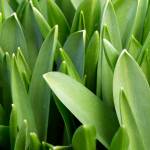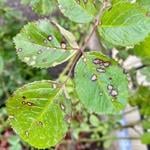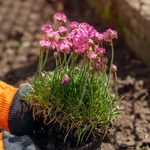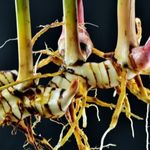
How to Grow Bearded Iris Rhizomes
Grow Guide #2912
Family: Iridaceae
Binomial name: Iris x germanica
Life Cycle: Perennial
This 'How to Grow' guide details everything a home gardener needs to know to plant, grow and care for Bearded iris (Iris x germanica).
When to Plant Bearded Iris Rhizomes
Ues the table below to find the best time to plant bearded iris rhizomes in your climate.
| JAN | FEB | MAR | APR | MAY | JUN | JUL | AUG | SEP | OCT | NOV | DEC | |
|---|---|---|---|---|---|---|---|---|---|---|---|---|
| Cool | ||||||||||||
| Temperate | ||||||||||||
| Sub-Tropical | ||||||||||||
| Tropical | ||||||||||||
| Arid |
Preparation
Bearded iris plants are best grown in full sun. Choose a location that will receive at least 6 hours of full sun each day.
Bearded iris plants are perennial, meaning they live for several years. Choose a permanent position where plants can grow undisturbed by regular digging.
Bearded iris plants are evergreen with leaves present throughout the year.
Bearded iris plants need a loose, well drained soil enriched with organic matter. Prepare soil by weeding it thoroughly, digging it over to at least a spade’s depth to loosen the soil, and adding aged animal manure or compost. Organic matter can be dug into heavy soil to lighten it so roots can grow freely. Keep the area free of weeds until planting. Learn more about preparing soil for planting here.
How to Plant Bearded Iris Rhizomes
Bearded iris rhizomes should be planted in their final position in the garden. Newly purchased rhizomes will have the leaves cut back ready for planting; when lifting and dividing rhizomes, prune the leaves to 15cm tall before planting.
- Plant individual rhizomes 20-40cm apart.
- Plant so the roots are buried but the top of the rhizome sits at the soil's surface. The tops of rhizomes can be covered with 1-2cm of soil when planted to prevent them being burnt by the sun.
- Water in well then keep soil relatively dry.
How to Grow Bearded iris
Bearded iris plants are drought tolerant once established and grow best in soil that is dry and very well drained. Let the soil dry out between watering, and only water when the soil is dry about 10cm below the surface (test this by scratching away a little soil with your finger), even in summer. Water deeply in the early morning or late afternoon. Avoid watering the leaves of plants to avoid fungal diseases. Learn more about watering here.
If soil was well prepared no extra fertiliser should be necessary. In poor soil or to give your plants an extra boost, application of a high-potassium fertiliser or one formulated for flowering plants can be beneficial:
- Apply slow release fertiliser at the recommended rate when transplanting or when seedlings are 5-10cm tall.
- Apply liquid fertiliser at the recommended rate and frequency while plants are fruiting or flowering.
Bearded iris plants should flower the summer after they are planted.
Deadhead bearded iris flowers regularly during the growing season. Using sharp secateurs or snips cut fading or dead flowers off just above a set of leaves. Removing old flowers regularly will encourage plants to produce more flowers. Learn more about deadheading flowering plants here.
If growing bearded iris for cut flowers, but stems while still in bud 1-2 days before they open. Use sharp snips and secateurs to cut the longest stems possible, placing stems immediately in a clean bucket of water. Cut spent flowers to allow other buds on the same stem to open. Learn more about cutting and conditioning homegrown flowers here.
Dead or untidy foliage can be removed in summer to tidy the plants.
Lift and divide rhizomes every three years to avoid overcrowding and encourage better flowering. After flowering, use a garden fork to lift the rhizomes with their roots attached. Use your hands or a clean, sharp knife to divide the rhizomes. Replant the rhizomes that have buds and roots attached and discard any old or dead ones. Before replanting, prune the leaves back to 15cm.
Common Problems when Growing Bearded iris
Like all plants, bearded iris is susceptible to some pests, diseases and other problems. Below is a list of the most common problems gardeners encounter when growing bearded iris plants:
 No flowers forming is often caused by too much shade, feeding with a high nitrogen fertiliser or inadequate nutrients. Some plants need a cold winter, sometimes with frosts, to induce flowering. Overcrowded clumps of bulbs, corms and rhizomes can also reduce flowering. Ensure plants receive the recommended amount of sunlight, feed with a low-nitrogen fertiliser formulated to encourage flowers, plant varieties suited to your climate, and lift and divide bulbs and corms when needed.
No flowers forming is often caused by too much shade, feeding with a high nitrogen fertiliser or inadequate nutrients. Some plants need a cold winter, sometimes with frosts, to induce flowering. Overcrowded clumps of bulbs, corms and rhizomes can also reduce flowering. Ensure plants receive the recommended amount of sunlight, feed with a low-nitrogen fertiliser formulated to encourage flowers, plant varieties suited to your climate, and lift and divide bulbs and corms when needed. Bacterial leaf spot is a disease that causes irregularly shaped brown spots on all above-ground parts of a plant. The spots at first appear to be wet but become dry and scab-like over time. Leaves and flowers can fall prematurely. Water plants at soil level (not on the leaves), dispose of fallen leaves and fruit and practice crop rotation.
Bacterial leaf spot is a disease that causes irregularly shaped brown spots on all above-ground parts of a plant. The spots at first appear to be wet but become dry and scab-like over time. Leaves and flowers can fall prematurely. Water plants at soil level (not on the leaves), dispose of fallen leaves and fruit and practice crop rotation. Grey mould (Botrytis sp.) is a fungal disease that causes flowers to become mouldy and fruit to rot. Spores are transported by wind and can survive in soil or on green waste. The fungus spreads most in cool, damp weather. Prune off affected flowers and fruit, water plants at soil level (not on leaves) and if necessary spray with an appropriate fungicide or homemade spray.
Grey mould (Botrytis sp.) is a fungal disease that causes flowers to become mouldy and fruit to rot. Spores are transported by wind and can survive in soil or on green waste. The fungus spreads most in cool, damp weather. Prune off affected flowers and fruit, water plants at soil level (not on leaves) and if necessary spray with an appropriate fungicide or homemade spray. Rust (Puccinia sp.) is a fungal disease that causes brown to orange raised spots or patches to appear on foliage. Fungal spores are spread by wind or water to neighbouring plants, especially in temperatures of 10-20C and when humidity is high. To manage rust, space plants to avoid overcrowding, grow them in the recommended amount of light (eg full sun), do not over fertilise crops, remove dead plants and practice crop rotation. Read more about rust fungus here.
Rust (Puccinia sp.) is a fungal disease that causes brown to orange raised spots or patches to appear on foliage. Fungal spores are spread by wind or water to neighbouring plants, especially in temperatures of 10-20C and when humidity is high. To manage rust, space plants to avoid overcrowding, grow them in the recommended amount of light (eg full sun), do not over fertilise crops, remove dead plants and practice crop rotation. Read more about rust fungus here. Crown rot is a soil-borne fungal disease that causes the roots and centres of plants to rot. Above-ground symptoms include the lower stems and branches of plants turning brown causing the plant to die from the bottom up. Reduce soil moisture, do not overwater plants, ensure soil is well-drained, or plant in raised beds or containers.
Crown rot is a soil-borne fungal disease that causes the roots and centres of plants to rot. Above-ground symptoms include the lower stems and branches of plants turning brown causing the plant to die from the bottom up. Reduce soil moisture, do not overwater plants, ensure soil is well-drained, or plant in raised beds or containers. Rotten rhizomes are caused by pathogens entering bulbs after sitting in cold, wet soil, being temporarily waterlogged or being exposed to warm temperatures in winter. Rhizomes may show obvious signs of rot, have no roots or shoots, or produce stunted yellow leaves but no flowers. Plant rhizomes in free-draining soil, raised garden beds or containers at the recommended depth; do not overwater rhizomes before shoots emerge.
Rotten rhizomes are caused by pathogens entering bulbs after sitting in cold, wet soil, being temporarily waterlogged or being exposed to warm temperatures in winter. Rhizomes may show obvious signs of rot, have no roots or shoots, or produce stunted yellow leaves but no flowers. Plant rhizomes in free-draining soil, raised garden beds or containers at the recommended depth; do not overwater rhizomes before shoots emerge.


.png)






